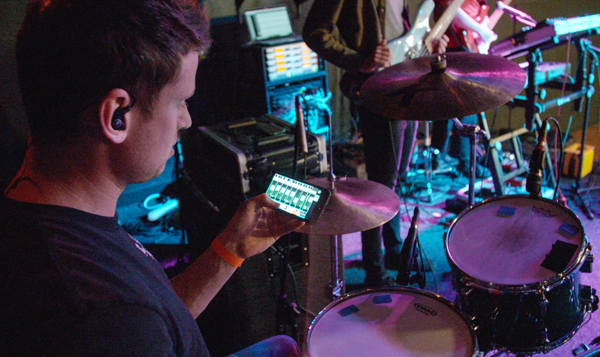Car Seat Headrest, which began in 2010 as singer/songwriter/multi-instrumentalist Will Toledo’s solo project, has developed into a 7-piece indie rock band, and in touring in the U.S., Canada, and parts of Europe, Toledo and bandmates Ethan Ives (guitar/keys), Seth Dalby (bass), Andy Katz (drums), and engineer John McRae have dealt with a wide variety of stage monitor systems.
“Monitors were always a crapshoot,” says McRae, who mixes front-of-house and monitors and handles tour management. “We were at the mercy of what the house could provide. Sometimes it was fine, sometimes it was not great but doable, and sometimes it was a total train wreck.”
The band has addressed these issues with a Mackie DL32R rack-mount digital mixer and new MP-series in-ear monitors. “I knew from the get-go that this band could really benefit from in-ear monitors,” McRae notes. “They have a fairly loud stage volume, combined with a lead singer who gets fairly quiet sometimes. Now we’re using the Mackie MP-220 and MP-240 professional in-ear monitors, which have a lot of isolation and really good sound quality.”
The Mackie MP series includes the MP-120, with one dynamic driver per in-ear; the MP-220, with two dynamic drivers; and the MP-240, which features a hybrid design with one dynamic driver and one balanced armature driver. The hybrid design is stated to provide up to 40 dB SPL of sound isolation that allows the players to hear crucial details of the mix. “Back when we used stage monitors, it was a wall of sound in my left ear,” reports Katz. “The Mackie in-ears are a lot nicer for us.”
Between the digital mixer and the in-ear monitors, the band now has a self-contained monitor rig. “In a typical venue you might have a monitor console and a front-of-house console,” McRae reflects. “We bring a monitor mixer but it fits in a three-space rack. Pretty much any show or festival, we can show up, and I just have to set up a few racks. I control it with an iPad. Each person has the Mackie Master Fader control app on their iPhone, and you can set it up so that they can only change their mix; they can’t make a mistake and change somebody else’s mix.”
“I can do everything with Master Fader,” explains Katz. “I can pan guitar stage right, I can pan bass stage left, I can have vocals dead center, and I can hear everything perfectly. I can turn it up, turn it down. It’s pretty great.”
From his iPad, McRae has wireless master control over all of the mixes. “My main job is front-of-house engineer,” he sayss, “so more often than not I’m 80 feet away, with 500 people between me and the stage. It’s not easy to run down there and make a quick change. With the DL32R, I don’t have to be onstage to make changes. And it’s nice to not have to worry about whether the monitors are gonna suck; with the Mackie DL32R mixer and MP-series in-ears, our monitors always sound great. The band can hear things that have historically been hard for them to hear. Monitors are not a problem anymore.”




